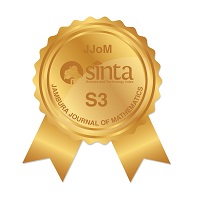Sensitivity, Optimal Control, and Cost-Effectiveness Analysis of Intervention Strategies of Filariasis
Abstract
Keywords
Full Text:
PDFReferences
B. K. Tyagi, Lymphatic Filariasis. Singapore: Springer, 2018.
T. B. Nutman, "Insights into the Pathogenesis of Disease in Human Lymphatic Filariasis" Lymphatic Research and Biology, vol. 11, no. 3, pp. 144-148, 2013, doi: https://doi.org/10.1089/lrb.2013.0021.
C. T. Goel and A. Goel, Lymphatic Filariasis. Singapore: Springer, 2016.
A. A. Arsin, Epidemiologi Filariasis di Indonesia, 1st ed. Makassar: Masagena Press Makassar, 2016.
A. K. Supriatna, H. Serviana, and E. Soewono, "A Mathematical Model to Investigate the Long-Term Effects of the Lymphatic Filariasis Medical Treatment in Jati Sampurna, West Java"ITB Journal of Sciences, vol. 41, no. 1, pp. 1-14, 2009, doi: https://doi.org/10.5614/itbj.sci.2009.41.1.1.
C. P. Bhunu and S. Mushayabasa, "Transmission Dynamics of Lymphatic Filariasis: A Mathematical Approach" ISRN Biomathematics, vol. 2012, pp. 1-9, 2012, doi: https://doi.org/10.5402/2012/930130.
P. M. Mwamtobe, S. M. Simelane, S. Abelman, and J. M. Tchuenche, "Mathematical analysis of a lymphatic filariasis model with quarantine and treatment" BMC Public Health, vol. 17, no. 1, p. 265, 2017, doi: https://doi.org/10.1186/s12889-017-4160-8.
S. M. Simelane, P. M. Mwamtobe, S. Abelman, and J. M. Tchuenche, "A Mathematical Model for the Transmission Dynamics of Lymphatic Filariasis with Intervention Strategies" Acta Biotheoretica, vol. 68, no. 3, pp. 297-320, 2020, doi: https://doi.org/10.1007/s10441-019-09370-y.
A. J. Iddi, "Lymphatic Filariasis Model with Prevention and Treatment in Human Under Treatment Barriers" International Journal of Scientific Research in Science, Engineering and Technology, pp. 280-292, 2020, doi: https://doi.org/10.32628/IJSRSET207263.
N. Chitnis, J. M. Hyman, and J. M. Cushing, "Determining Important Parameters in the Spread of Malaria Through the Sensitivity Analysis of a Mathematical Model" Bulletin of Mathematical Biology, vol. 70, no. 5, pp. 1272-1296, 2008, doi: https://doi.org/10.1007/s11538-008-9299-0.
K. O. Okosun, O. Rachid, and N. Marcus, "Optimal control strategies and cost-effectiveness analysis of a malaria model, "Biosystems, vol. 111, no. 2, pp. 83-101, 2013, doi: https://doi.org/10.1016/j.biosystems.2012.09.008.
F. Agusto, "Optimal isolation control strategies and cost-effectiveness analysis of a two-strain avian influenza model, "Biosystems, vol. 113, no. 3, pp. 155-164, 2013, doi: https://doi.org/10.1016/j.biosystems.2013.06.004.
P. Rodrigues, C. J. Silva, and D. F. M. Torres, "Cost-Effectiveness Analysis of Optimal Control Measures for Tuberculosis" Bulletin of Mathematical Biology, vol. 76, no. 10, pp. 2627-2645, 2014, doi: https://doi.org/10.1007/s11538-014-0028-6.
A. Hugo, O. D. Makinde, S. Kumar, and F. F. Chibwana, "Optimal control and cost effectiveness analysis for Newcastle disease eco-epidemiological model in Tanzania" Journal of Biological Dynamics, vol. 11, no. 1, pp. 190-209, 2017, doi: https://doi.org/10.1080/17513758.2016.1258093.
B. Buonomo and R. Della Marca, "Optimal bed net use for a dengue disease model with mosquito seasonal pattern" Mathematical Methods in the Applied Sciences, 2017, doi: https://doi.org/10.1002/mma.4629.
P. Van Den Driessche and J. Watmough, "Reproduction numbers and sub-threshold endemic equilibria for compartmental models of disease transmission" Mathematical Biosciences, vol. 180, no. 1-2, pp.29-48, 2002, doi: https://doi.org/10.1016/S0025-5564(02)00108-6.
W. Nur, Trisilowati, A. Suryanto, and W. M. Kusumawinahyu, "Mathematical model of schistosomiasis with health education and molluscicide intervention" Journal of Physics: Conference Series, vol. 1821, no. 1, p. 012033, 2021, doi: https://doi.org/10.1088/1742-6596/ 1821/1/012033.
E. P. Astuti, M. Widawati, Y. Yuliasih, A. Ruliansyah, and A. J. Kusnandar, "Lama hidup dan potensi culex quinquefasciatus sebagai vektor filariasis limfatik berdasarkan ketinggian pasca transmission assesment survey (tas) di kabupaten subang, Jawa Barat" Vektora : Jurnal Vektor dan Reservoir Penyakit, vol. 12, no. 2, pp. 155-166, 2020, doi: https://doi.org/10.22435/vk.v12i2.3241.
M. Maksud, S. Chadijah, H. Mustafa, A. Kurniawan, and M. Murni, "Keanekaragaman Spesies Nyamuk di Daerah Transmission Assesment Survey (TAS) Filariasis di Kabupaten Enrekang, Provinsi Sulawesi Selatan" BALABA: Jurnal Litbang Pengendalian Penyakit Bersumber Binatang Banjarnegara, pp. 79-90, 2020, doi: https://doi.org/10.22435/blb.v16i1.2814.
W. A. Stolk, S. J. de Vlas, and J. D. F. Habbema, "Advances and challenges in predicting the impact of lymphatic filariasis elimination programmes by mathematical modelling" Filaria Journal, vol. 5, no. 1, p. 5, 2006, doi: https://doi.org/10.1186/1475-2883-5-5.
M. Ismail, R. Jayakody, G. Weil, D. Fernando, M. De Silva, G. De Silva, and W. Balasooriya, "Long-term efficacy of single-dose combinations of albendazole, ivermectin and diethylcarbamazine for the treatment of bancroftian filariasis" Transactions of the Royal Society of Tropical Medicine and Hygiene, vol. 95, no. 3, pp. 332-335, 2001, doi: https://doi.org/10.1016/S0035-9203(01)90257-3.
H. A. Farid, S. A. Kamal, G. J. Weil, F. K. Adham, and R. M. R. Ramzy, "Filariasis elimination in Egypt: impact of low microfilaraemics as sources of infection for mosquitoes." Eastern Mediterranean health journal, vol. 9, no. 4, pp. 863-72, 2003.
DOI: https://doi.org/10.34312/jjom.v4i1.11766
Copyright (c) 2022 Darmawati Darmawati, Musafira Musafira, Darma Ekawati, Wahyudin Nur, Muhlis Muhlis, Siti Fatima Azzahra

This work is licensed under a Creative Commons Attribution-NonCommercial 4.0 International License.
Jambura Journal of Mathematics has been indexed by
Jambura Journal of Mathematics (e-ISSN: 2656-1344) by Department of Mathematics Universitas Negeri Gorontalo is licensed under a Creative Commons Attribution-NonCommercial 4.0 International License. Powered by Public Knowledge Project OJS.
Editorial Office
Department of Mathematics, Faculty of Mathematics and Natural Science, Universitas Negeri Gorontalo
Jl. Prof. Dr. Ing. B. J. Habibie, Moutong, Tilongkabila, Kabupaten Bone Bolango, Gorontalo, Indonesia
Email: [email protected].



















